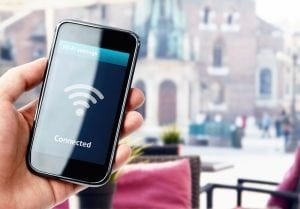
Keep your information safe when using public networks
We’ve all been in a situation where we are in our favorite restaurant or coffee shop, waiting for a flight, settling into our hotel room, or shopping at our favorite retailer and check to see if a Wi-Fi connection is available. We look to Wi-Fi as a convenient connection source when we’re not at home, and don’t have another way to connect to the internet or don’t want to worry about using up a mobile data allotment. It might be habit at this point to use what’s around us, especially with how common it’s become, but you may want to reconsider using that public Wi-Fi connection.
Public Wi-Fi connections aren’t always safe, even if they are password protected. Once you’re connected your mobile device, tablet or laptop may be vulnerable to a hacker lurking on that same network ready to intercept any unencrypted data. The network may also give the appearance of looking legitimate, by using familiar naming conventions, but could potentially be a ruse to lure you into a false sense of security. With your personal and business data at stake, it’s important to know some tips to keep you from getting scammed:
- Connect via Virtual Private Network: A Virtual Private Network (VPN) is the safest way to use a public Wi-Fi network. This is essentially like exiting off of a very busy highway and entering a lane that only you have access to. You may have this set up on a work computer already, but VPNs can also be used on personal devices as well and are recommended to keep your data secure.
- Verify the network you intend to use: The main point here is to not automatically assume an open network belongs to the establishment you are visiting. Hackers can launch their own networks that could look similar to the one you are intending to connect to. Once connected, they will be able to see all data being transmitted and they can upload malicious software to your device. The best way to avoid this is to ask someone who works at that location to verify the correct network.
- Don’t auto connect to a public network: When making a connection to a Wi-Fi network, you are prompted with an option to auto connect to this network when you are within range. This feature should be limited to your home network. When enabled, any time you are within range of that connection you will automatically connect even if you didn’t intend to. This could leave your devices vulnerable while you are in range of the network if your guard is down. It doesn’t hurt to go back into your settings of the device you are using and choose the “Forget this Network” option when you are finished using the public network, to purge it from your device.
- Stick to secure sites: When browsing sites, take a moment to verify if the web address you are visiting contains “HTTPS” at the front. If you see “HTTP” that means the site is not encrypted, whereas “HTTPS” denotes that data moving from your device to the server that hosts that site is encrypted. This encryption makes it more difficult for an attacker to capture your data. If you don’t see the “S” at the end, you may want to steer clear of that site until you are on a more secure network.
- Don’t make any transactions: Whether you are on an encrypted site or not, it is still recommended to avoid making any purchases or visiting sites that contain your banking information. It’s better to be safe than sorry when it comes to the potential for identity theft.
- Skip public Wi-Fi altogether: If you want to make transactions, visit your banking site or peruse your favorite social media sites without fear; or don’t have a VPN set up, consider using a mobile network (mobile hotspot) instead. This could mean just making sure Wi-Fi is turned off on your mobile phone and using your carrier’s network. If you have some important work to do that requires the use of a laptop, you can use your phone or a hotspot as an access point; pulling in data from the mobile network to generate a private, password-protected access point for your other devices.
Public Wi-Fi is not inherently a bad thing. It’s a convenient way for us to stay connected with the people and services we care about when we are away from our home network. It’s important to keep your guard up and use safe practices when you do connect to a public connection.
